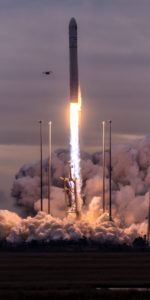
Only months before its purchase by Northrop Grumman is expected to be finalized, Orbital ATK plans to launch its next Cygnus cargo freighter (OA-8) to the International Space Station (ISS), no sooner than Saturday, 11 November, during a five-minute “window”, which opens at 7:37 a.m. EST. The mission will mark the return of the Dulles, Va.-based company’s Antares booster, flying out of Pad 0A at the Mid-Atlantic Regional Spaceport (MARS) on Wallops Island, Va. Loaded with over 7,000 pounds (3,100 pounds) of equipment, supplies and research hardware for the incumbent Expedition 53 crew, OA-8 is expected to arrive at the space station early Monday, berthing at the Earth-facing (or “nadir”) port of the Unity node, where it will remain for three weeks.
In keeping with tradition, OA-8 has been named for a fallen astronaut; in this case, Gene Cernan, the last Apollo Moonwalker, who died in January, aged 82. Selected as a NASA astronaut in October 1963, he served aboard three space missions, performing a hazardous, two-hour spacewalk on Gemini IX-A in June 1966, achieving the fastest confirmed record ever clocked by a manned spacecraft during Apollo 10’s return from the Moon in May 1969 and logging the greatest number of hours on the lunar surface, in command of Apollo 17 in December 1972. Cernan also worked on the planning, development and evaluation of the joint U.S./Soviet Apollo-Soyuz Test Project (ASTP) and served as chief of astronaut training operations, before retiring from NASA and the U.S. Navy—having attained the rank of Captain—in July 1976. He logged 566 hours in space, one period of Extravehicular Activity (EVA) and three Moonwalks, totaling more than 24 hours.
“Our #OA8 #Cygnus spacecraft is named in honor of Gene Cernan, accomplished @USNavy Captain & @NASA astronaut,” Orbital ATK tweeted last month. The OA-8 mission is part of the $1.9 billion Commercial Resupply Services (CRS) contract, signed between Orbital Sciences Corp. and NASA, back in December 2008, which called for at least eight Cygnus flights to deliver 44,000 pounds (20,000 kg) of equipment, payloads and supplies to successive ISS crews. The missions would fly atop Orbital’s homegrown Antares booster. A “demonstration” mission (ORB-D) in September 2013 was followed by two successful “operational” flights (ORB-1 and ORB-2) in January and July 2014, before catastrophe engulfed ORB-3, shortly after liftoff the following October.

This failure led to a decision to fly at least two future Cygnus missions aboard United Launch Alliance (ULA) Atlas V boosters, until Antares could be restored to operational service. Two ULA-launched Cygnuses—“OA-4” and “OA-6”, renumbered in recognition of the Orbital ATK merger—flew in December 2015 and March 2016, before Antares returned to flight in October 2016 with OA-5. A further mission, OA-7, was lofted atop an Atlas V earlier this year, with tomorrow’s launch of OA-8 expected to see Antares pick up the baton for all future Cygnus flights. Each mission has honored a fallen U.S. astronaut, including Project Mercury heroes Deke Slayton (twice) and John Glenn, veteran shuttle fliers G. David Low, Janice Voss, C. Gordon Fullerton, Rick Husband and Alan Poindexter and, most recently, Moonwalker Gene Cernan. All told, the seven fully successful Cygnuses to date have trucked a combined total of 35,480 pounds (16,100 kg) of payloads and supplies to more than ten ISS increments.
Tomorrow’s OA-8 will be the fifth spacecraft to benefit from the so-called “Enhanced Cygnus” configuration, equipped with a “stretched” Pressurized Cargo Module (PCM), which increases the interior volume to 950 cubic feet (27 cubic meters) and allows for an approximately 60-percent larger haul of payloads to be lofted, compared to its predecessor, the “Standard Cygnus”. The PCM for the OA-8 mission was delivered to Wallops in late June for processing, with an expectation that launch could occur as early as September. This ultimately slipped into October, and eventually November, at NASA’s direction. Last month, the OA-8 Service Module (SM)—which houses a pair of lightweight, high-capacity UltraFlex solar arrays—was delivered to Wallops and the two spacecraft elements were integrated. When fully assembled, the OA-8 Cygnus stood 15.9 feet (4.86 meters) tall and 10.1 feet (3.07 meters) in diameter, about 3.9 feet (1.2 meters) higher than the Standard Cygnus, which launched four times between September 2013 and October 2014.

As outlined in a recent OA-8 science briefing, the mission will ferry a wide range of research payloads into orbit for the station’s incumbent Expedition 53 crew. The cargo mass will total 7,385 pounds (3,350 kg), including 1,461.7 pounds (663 kg) of science hardware. The E. coli AntiMicrobial Satellite (EcAMSat) will employ a deployable CubeSat to investigate the resistance of the bacterial pathogen E. coli to a group of antibiotics, as part of efforts to better understand the dangers posed to astronauts, whose immune systems are weakened by microgravity. Other experiments include a study of the effects of microgravity on Microclover legumes, mealworms and mustard plants.
Several technology investigations will also be aboard OA-8. The Optical Communications and Sensor Demonstration (OCSD) is part of an ongoing CubeSat project and will see evaluations of laser communications and proximity operations, using cameras, beacons, laser-rangefinders and relative maneuvering using variable drag and water-steam propellant. Results from this experiment could lead to significantly enhanced space-to-ground communications speeds, coupled with an improved understanding of laser communications between small satellites in low-Earth orbit. The Integrated Solar Array and Reflectarray Antenna (ISARA) will test a hybrid solar panel and Ka-band communications solar antenna, as a potential solution for sending and receiving information to and from faraway destinations, both on Earth and in space.

In addition to the science hardware, OA-8 also carries 2,740.3 pounds (1,243 kg) of crew supplies, 2,054.7 pounds (932 kg) of vehicle-related equipment, 75 pounds (34 kg) of computer resources and 310.9 pounds (141 kg) of EVA gear. Assuming an on-time launch on Saturday morning, the Cygnus will reach the ISS early Monday, to be captured by the station’s 57.7-foot-long (17.6-meter) Canadarm2 robotic arm at about 5:40 a.m. EST. Leading the capture effort will be European Space Agency (ESA) astronaut Paolo Nespoli, at the controls of Canadarm2, backed-up by Expedition 53 Commander Randy Bresnik. Cygnus is expected to be berthed at the nadir port of Unity at about 7:40 a.m.
Last week, the crew worked extensively on preparations for OA-8’s arrival. They readied rack fronts in the Permanent Multipurpose Module (PMM)—situated on the forward-facing port of the station’s Tranquility node—to accommodate cargo, by moving smaller items off and staging them for disposal. NASA noted that, during OA-8 cargo operations, the items marked for disposal will be swapped with new cargo arriving aboard Cygnus.
The cargo ship’s arrival will begin an expected three weeks of operations, as Nespoli, Bresnik and their comrades—U.S. astronauts Mark Vande Hei and Joe Acaba and Russian cosmonauts Sergei Ryazansky and Aleksandr Misurkin—unpack Cygnus and reload it with unwanted equipment for its destructive return to Earth. OA-8 is scheduled to be robotically detached from the Unity node on 3 December, but will remain grappled by Canadarm2 and maneuvered to vicinity of the space-facing (or “zenith”) port of the Harmony node. According to NASA, this 12-hour test is “part of a data-gathering exercise for a future mission when a Commercial Crew vehicle could partially block Global Positioning System (GPS) antennas typically used during a Cygnus approach”. Assuming all goes well, OA-8 will be released by Canadarm2 on 4 December, with an expectation that it will perform a destructive re-entry on the 18th.





